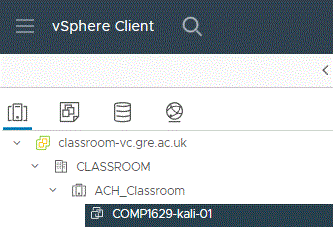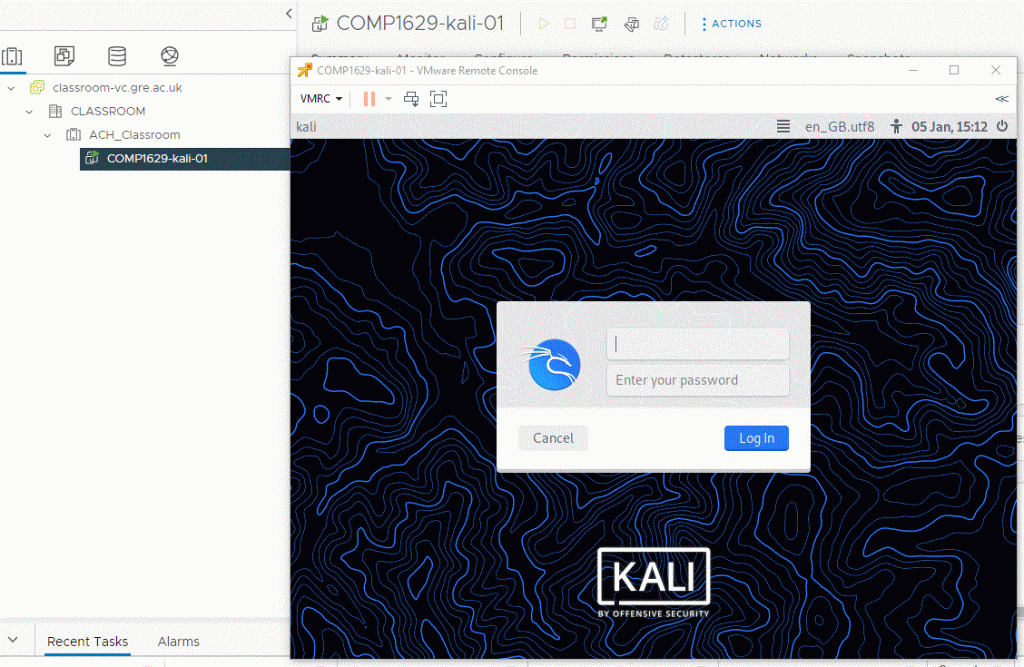The Virtual Classroom Environment is used in teaching on several modules where students need to perform tasks that are not possible in the general labs, for example:
- Network and Operating systems modules where students need to install operating systems, configure services on servers etc.
- Database administration modules where each students needs to create and administer their own database server.
- Penetration Testing modules where students need to run scans and attack vulnerable servers and systems
Logging in
The Classroom Environment is only accessible from within the University network, or from the virtual desktop if you are outside the University.
If you are outside the University you need to use the Microsoft Remote Desktop client to access virtual desktop – if you access it from a web browser you won’t be able to type in your virtual machine.
To access the Classroom Environment open a web browser (we recommend you use Google Chrome however Microsoft Edge can be used too) and browse to the URL
https://classroom-vc.gre.ac.uk/ui
And login with your University username (NOT username@gre.ac.uk) and password when prompted.
Please note that if your password contains special characters such as ` @ % ^ & < > then you may not be able to login as VMware vCenter does not accept passwords with those characters in. If that is the case you will need to change your password to be able to login. See https://www.gre.ac.uk/it-and-library/password for instructions on how to do this.
Staff users will need to put staff\their-username as the username.
Accessing your Virtual Machines
Once you have logged in, click on the “>” next to “classroom-vc.gre.ac.uk” and then the “>” next to “CLASSROOM” and so on in the left hand pane to see the VMs that you have access to.

Note that the number of VMs you see will depend on which modules you are enrolled on. and whether the module leader has decided you will work in groups or are assigned individual VMs. Ensure you only access the VM your lecturer has assigned to you / your group.
VMs that are powered on will have a green triangle pointing right to indicate this – in the above example the VM is powered off.
To power on a VM that is off, select it in the left hand pane, and then right click on it, and from the menu that appears click “Power” -> “Power On”:

After a few second the VM will have a green triangle showing it is powered on:

Using your Virtual Machines
For the best experience when using your VMs we recommend that you open the console in the Remote Console and not in the Web Console.
The VMware Remote Console (VMRC) will already be installed in the CMS labs in King William, on the virtual desktop, and in other labs where modules that use the Classroom Environment are taught. In other locations at the University (e.g. the library) you may need to install the VMRC from Software Center.
To access the console of your VM select the “Open Remote Console” option from the right click menu or click “Launch Remote Console” from the Summary tab of the middle pane. Depending on which browser you are using, you may be prompted to confirm you want to open the VMRC – say yes / open when prompted.
The VMRC will now launch and you can access the console of your VM from it.

The VMRC menu gives options for sending Ctrl-Alt-Del, powering on the VM etc.
Note that if the VMRC does not start then it is most likely not installed on the computer you are using and you will need to go to Software Centre to install it.
Typing in your VM in virtual desktop
To be able to type in your VM when using accessing it from virtual desktop you need to ensure you use the Microsoft Remote Desktop Client to access virtual desktop (see https://www.gre.ac.uk/it-and-library/connect/studentdesktop for instructions on setting this up). If you access virtual desktop through a web browser you will not be able to type in your VM.
Copying and pasting to/from your VM
Copy and paste has been enabled to allow you to copy commands into your VM and copy results out etc. If you have problems with this try restarting your VM first, and if that doesn’t resolve the issue contact the support team. If you are using virtual desktop, you cannot directly copy / paste from your own computer into virtual desktop or your VM, you will need to save anything you want to copy in or out to OneDrive first.
Help with the Classroom Environment
If you have any problems with the tutorials or coursework that you need to use your VMs for you should speak to your module leader or tutorial assistant in the first instance.
If you have any problems using the Classroom Environment, can’t access VMs you should be able to or have a general question about the Classroom Environment please contact cms-support@gre.ac.uk.
Please ensure you include your University username, what module you are studying, the names of the VMs you are having trouble with and information on any error message(s) you are getting (include screenshots if possible) as this will allow us to investigate your problem quicker.




